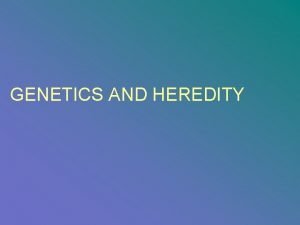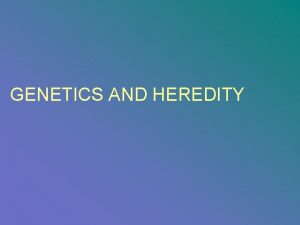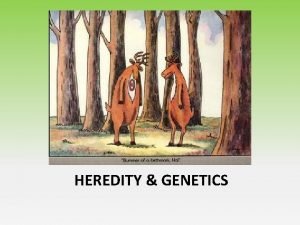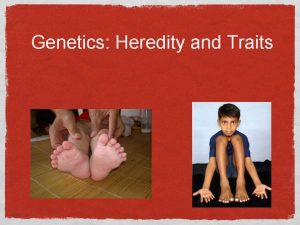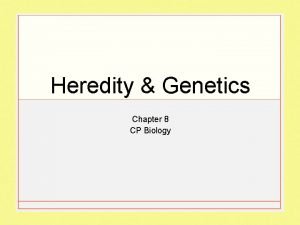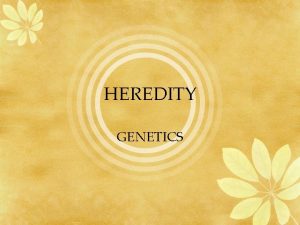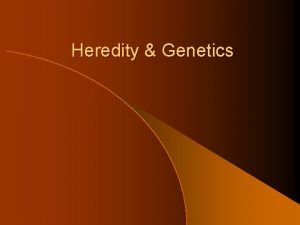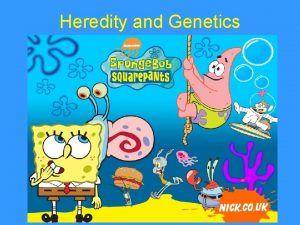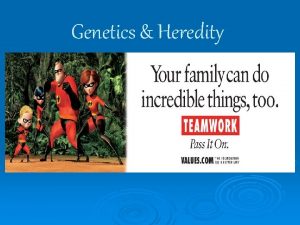Heredity and Genetics Heredity and Genetics Every person










- Slides: 10

Heredity and Genetics

Heredity and Genetics Every person inherits traits such as hair and eye color as well as the shape of their earlobes from their parents. Inherited traits can also be influenced by the environment. Height is an inherited trait but poor nutrition may limit growth during childhood. Other inherited traits can be impacted by the environment including body size and the tendency for certain diseases like diabetes. Most of the cells in the human body contain a nucleus, the control center of a cell. Inside each nucleus is a set of chromosomes (thread-like structures found within the nucleus of a cell that carry the codes for inherited traits). Most of the cells in the human body contain 46 chromosomes that are arranged in 23 pairs. Sections of chromosomes, called genes, are the basic units of heredity. Genes occur in pairs, just like chromosomes. One gene from each pair in inherited from each parent. You have thousands of genes in every cell of your body.

DNA (deoxyribonucleic acid) is the chemical unit that makes up chromosomes. All living things are made of DNA is made up of chemical building blocks arranged along a single molecule. Several of these molecules are linked together in a strand to form a DNA sequence known as the genetic code. When a child is born, that child carries a combination of DNA sequencing from both parents. The DNA contains different proteins that result in individual traits. All the characteristics you have, suc as eye color, the amount of curl in your hair, and your height are determined by your genetic code. Only identical twins share the same DNA pattern.

Genetics and Fetal Development Passing on traits from parent to child involves genetics. Most human cells have 46 chromosomes or 23 pairs. Egg and sperm cells have half that number, 23 chromosomes. The resulting zygote will have 46 chromosomes. These chromosomes carry the hereditary traits of the parents. Dominant and Recessive Genes Each human trait is determined by at least one pair of genes. Some genes are dominant while others are recessive. Dominant traits usually appear in the offspring when they are present. The traits of the recessive genes only appear when the dominant traits are not present. 2 genes (1 blue eye + 1 brown eye) = brown eyes brown eye gene is dominant and blue eye gene is recessive If an individual has blue eyes, that means they have two recessive genes for blue eye color.

The genotypic ratio describes the number of times a genotype (determines the expression of a particular characteristic or trait) would appear in the offspring after a test cross. For example, a test cross between two organisms with same genotype, Tt will result in offspring with genotypes: TT, Tt, and tt. In this example, the predicted genotypic ratio is 1: 2: 1. Phenotypic ratio pertains to the relative number of offspring manifesting a particular trait or combination of traits. Phenotype which is the expression of a particular trait, for example, skin color, height, behavior, etc. , according to the individual’s genetic makeup and environment.

Genes and Gender One pair of chromosomes determines gender. Females have two chromosomes that look exactly alike; these are called X chromosomes. Males have two different chromosomes, one shorter than the other. The shorter chromosome is the Y chromosome and the longer one is the X chromosome. Since sperm and egg cells contain only half the chromosomes of other cells, these cells have only one sex cell, not two. Since females have only X chromosomes, their eggs contain only an X chromosome. Sperm contain either an X or a Y chromosome. Because of this, the male determines the gender of the child. If the sperm cell carries the X chromosome, the child will be a girl. If the sperm cell carries a Y chromosome, the child will be a boy

Genetic Disorders A person can inherit genes that contain a mutation or abnormality. The mutation may have Little or no effect on the person. Some of the genetic mutations may result in a birth defect or May increase a person’s likelihood of developing a disease. These diseases are called genetic disorder s. Genetic disorders are caused partly or completely by a defect in genes. Some disorders may be apparent at birth where others may not show up until later in life. Common Human Genetic Disorders Sickle-cell anemia Sickle cell anemia is a disease passed down through families in which red blood cells form an abnormal sickle or crescent shape. It is caused by an abnormal type of hemoglobin called hemoglobin S. Hemoglobin is a protein inside red blood cells that carries oxygen. Hemoglobin S changes the shape of red blood cells. The red blood cells become shaped like crescents or sickles. The fragile, sickle-shaped cells deliver less oxygen to the body's tissues. They can also get stuck more easily in small blood vessels, as well as break into pieces that can interrupt healthy blood flow. These problems decrease the amount of oxygen flowing to body tissues even more. These problems can also result in sever joint and abdominal pain, weakness, kidney disease, and restricted blood flow.

Tay-Sachs Disease Tay-Sachs disease is caused by a genetic mutation in the HEXA gene on (human) chromosome 15. Destruction of nervous system, blindness, paralysis, and death during early childhood occurs. Cystic Fibrosis Cystic fibrosis is a disease passed down through families that causes thick, sticky mucus to build up in the lungs, digestive tract, and other areas of the body. It is one of the most common chronic lung diseases in children and young adults. It is a life-threatening disorder. Down Syndrome Down syndrome is a genetic condition in which a person has 47 chromosomes instead of the usual 46. Down syndrome occurs when there is an extra copy of chromosome 21. This form of Down syndrome is called Trisomy 21. The extra chromosome causes problems with the way the body and brain develop. They may be of short stature, have a round face with upper eyelids that cover the inner corners of the eye. Down syndrome is one of the most common causes of human birth defects. Hemophilia is the failure of blood to clot. In most cases, hemophilia is passed down through families (inherited). It most often affects males.

Technologies to Treat Genetic Disorders Amniocentesis A procedure in which a syringe is inserted through a pregnant female’s abdominal wall to remove a sample of the amniotic fluid surrounding the developing fetus. Doctors examine the chromosomes in fetal cells for genetic abnormalities. This is performed 16 to 20 weeks after fertilization. Chorionic Villi Sampling (CVS) A procedure in which a small piece of membrane is removed from the chorion, a layer of tissue that develops into the placenta. The tissue can be examined for genetic disorders or to determine the age and gender of the fetus. The procedure is done around the eighth week of fetal development.

Battling Genetic Disorders Genetic disorders occur when an individual is missing a functioning gene. Without the gene, the body does not produce some of the substances it needs. One experimental treatment is gene therapy. Gene therapy is the process of inserting normal genes into human cells to correct genetic disorders. Scientists feel that once a defective gene is replaced with a normal gene, the cells can then begin producing the normal gene. Placing parts of DNA from one organism into another is called genetic engineering. Genetic Counseling Genetic counselors can guide families of children with genetic disorders on treatments options. Genetic counseling offers options to people with a family history of some diseases. They can educate families about possible risks for certain diseases and guide families through their options.
 Microsoft mission statement
Microsoft mission statement Genetics is the study of heredity and variation
Genetics is the study of heredity and variation Chapter 17 lesson 2 heredity and genetics
Chapter 17 lesson 2 heredity and genetics 2nd person point of view
2nd person point of view 2 person singular
2 person singular Person person = new person()
Person person = new person() First person second person third person chart
First person second person third person chart Every country and every nation
Every country and every nation Every nation and every country
Every nation and every country Every picture has a story and every story has a moment
Every picture has a story and every story has a moment Every knee shall bow every tongue confess
Every knee shall bow every tongue confess











